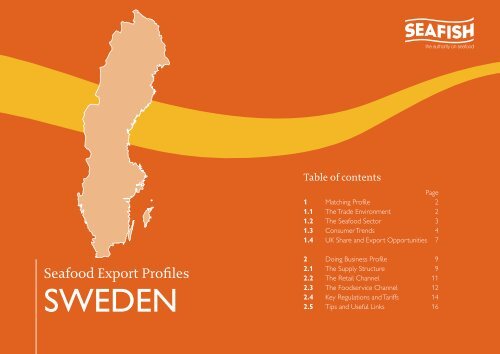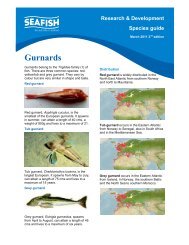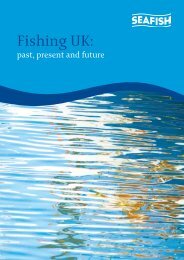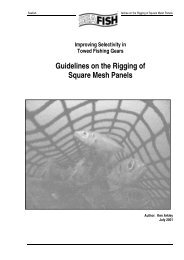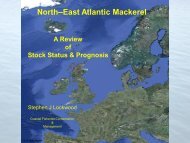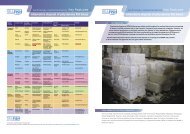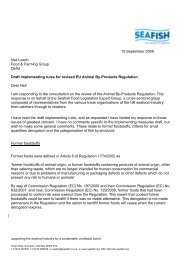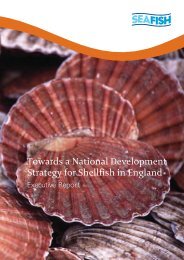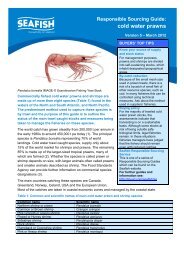SWEDEN - Seafish
SWEDEN - Seafish
SWEDEN - Seafish
You also want an ePaper? Increase the reach of your titles
YUMPU automatically turns print PDFs into web optimized ePapers that Google loves.
Table of contents<br />
Page<br />
1 Matching Profile 2<br />
1.1 The Trade Environment 2<br />
1.2 The Seafood Sector 3<br />
1.3 Consumer Trends 4<br />
1.4 UK Share and Export Opportunities 7<br />
Seafood Export Profiles<br />
<strong>SWEDEN</strong><br />
2 Doing Business Profile 9<br />
2.1 The Supply Structure 9<br />
2.2 The Retail Channel 11<br />
2.3 The Foodservice Channel 12<br />
2.4 Key Regulations and Tariffs 14<br />
2.5 Tips and Useful Links 16
SECTION 1MATCHING PROFILE<br />
1.1 THE TRADE ENVIRONMENT<br />
Fast facts<br />
Source: Statistics Sweden<br />
Population<br />
9.1 million<br />
Land area<br />
449,964 sq km<br />
Inhabitants per sq km 22.05<br />
No. of households<br />
4.47 million<br />
Capital<br />
Stockholm<br />
Other main cities<br />
Gothenburg, Malmo<br />
Languages<br />
Swedish<br />
Religion<br />
Protestant, Lutheran<br />
Currency<br />
Swedish Krona (SEK)<br />
Exchange rate (2006) SEK:€ = 9.26<br />
Total GDP (2006)<br />
SEK 2,899 billion<br />
Real GDP growth rate (2006) 4.2%<br />
GDP per capita (2006) SEK 320,483<br />
Inflation (2006) 1.36%<br />
Unemployment rate (2006) 5.5%<br />
International status<br />
Member of the EU<br />
Government type<br />
Constitutional monarchy<br />
Total food and drink imports £5.95 billion<br />
Total food and drink exports £3.07 billion<br />
Top 3 import countries<br />
Norway, Denmark, Netherlands<br />
• Sweden's GDP is projected to grow<br />
rapidly in 2008. Growth in goods<br />
exports decelerated in 2007 but is<br />
likely to recover in 2008. Due to<br />
increasing disposable income, rising<br />
employment and a solid wealth<br />
position, household consumption<br />
is projected to increase substantially<br />
in the coming year. Strong finances<br />
in the local government sector are<br />
driving growth in the sector's<br />
consumption.The Government<br />
expects that the economy will be<br />
boosted over the coming years.<br />
• Today the foreign-born population<br />
stands at 1.1 million, or about 12%,<br />
according to the Organisation for<br />
Economic Co-operation and<br />
Development (OECD).<br />
The proportion is greater than<br />
in Britain, and nearly twice as high<br />
as in Denmark. A total of 86,436<br />
people were granted residence<br />
permits in Sweden in 2006, 19,037<br />
of them as refugees or other<br />
protective grounds or for<br />
humanitarian reasons.<br />
• Ethnic groups include indigenous<br />
Swedes, ethnic Finns, and ethnic Sami.<br />
The key immigrant populations are<br />
Finns, Iraqis, ex-Yugoslavia nationals,<br />
Iranians, Norwegians, Danes, Greeks,<br />
and Turks.<br />
• People are also emigrating: 34,365<br />
Swedish residents left the country<br />
during the first nine months of 2007,<br />
a five percent increase over the same<br />
time period last year. Most of these<br />
are Swedish-born citizens moving<br />
to another Nordic country or an<br />
English-speaking country.<br />
• An increasing number of companies<br />
are facing labour shortages but at the<br />
same time employment has risen.<br />
It is expected that there will be<br />
pressure for higher wages over the<br />
coming years which again will result<br />
in increasing inflation.The Central<br />
Bank is also likely to raise interest<br />
rates to a predicted maximum of 4.7%<br />
during 2009.The cumulative impact<br />
could dampen the Swedish economy in<br />
the short term whereas longer term<br />
heavy growth rates are expected.<br />
Seafood Export Profiles <strong>SWEDEN</strong> 2
SECTION 1MATCHING PROFILE<br />
1.2 THE SEAFOOD SECTOR<br />
Table 1: Top 10 species landed in Sweden 2005-2006<br />
Rank Species 2005 (£m) 2006 (£m) % Chg 05/06<br />
1 Cod 14.1 15.9 12.8<br />
2 Herring 9.6 11.1 15.6<br />
3 Coldwater prawn 9.5 10.2 7.4<br />
4 Nephrops 7.1 9.1 28.2<br />
5 Sprat 5.4 4.8 -12.5<br />
6 Lemon sole 1.5 1.3 -15.4<br />
7 Vendace 0.4 0.7 7.5<br />
8 Saithe 0.3 0.5 66.7<br />
9 Monkfish 0.3 0.2 -50.0<br />
10 Dover sole 0.1 0.2 100.0<br />
• The following product groups account for an<br />
estimated 50% of total seafood consumption.<br />
Herring and salmon are both key components<br />
in classic Swedish dishes. Cod is popular and found<br />
in many dishes. Shrimp is also very popular<br />
• Cod, herring, coldwater prawns and nephrops<br />
were, economically, the most important species<br />
landed in 2006. All four key species are in positive<br />
growth, whereas sprat and lemon sole experienced<br />
double digit decrease.<br />
• There are a large number of landing sites in Sweden.<br />
The most important are the harbours of Träslövsläge,<br />
Göteborg, Ängholmen, Smögen, and Strömstad on<br />
the west coast; and Trelleborg, Simrishamn, Karlskrona,<br />
Nogersund,Västervik, and Oxelösund in the Baltic.<br />
• The fishing industry represents a minor part of<br />
Sweden’s economy but is nonetheless very important<br />
in some coastal areas. However, the recreational fishing<br />
market in Sweden is greater than the commercial<br />
market according to a newly released report from<br />
Fiskeriverket,The Swedish Fishery Board value the<br />
socio economic value of sport fishing at £85 million.<br />
• The most important supply sources for the Swedish<br />
market are the domestic processing industry and<br />
imports. Both Swedish fresh seafood landings and<br />
aquaculture production are less important than<br />
direct inputs for domestic consumption.<br />
• The volume of Swedish seafood imports for direct<br />
consumption is difficult to calculate because of the<br />
re-export from Norway (non-EU country)<br />
via Sweden into the EU markets.<br />
• Per capita consumption of seafood in Sweden<br />
is officially estimated at between 17 to 18kg a year<br />
and this level has been stable in recent years.<br />
• Several Danish harbours, such as Skagen and<br />
Hanstholm, are also important for landing<br />
Swedish catches.<br />
• According to the Swedish Coast Guard the largest<br />
fishery ports in Sweden are Gothenburg<br />
Web: www.portgot.se/prod/hamnen/ghab/dalis2b.nsf<br />
and Simrishamn<br />
Web: www.simrishamn.se/externa/hamnar/index.html<br />
More information on Swedish ports is available at<br />
Web: http://portfocus.com/sweden/<br />
Seafood Export Profiles NETHERLANDS 3
SECTION 1MATCHING PROFILE<br />
1.3 CONSUMER TRENDS<br />
• Swedish consumers are becoming<br />
increasingly environment and health<br />
conscious in their choice of food and<br />
in general the Swedes see seafood as<br />
a healthy alternative to meat. Recent<br />
data on seafood consumption is not<br />
available, however, the perception<br />
among fish traders is that consumption<br />
of value added seafood products is<br />
increasing, while consumption of fresh<br />
seafood is relatively stable.The general<br />
increase in consumption is also partly<br />
attributable to successful promotions<br />
of the organization Svensk Fisk<br />
(Swedish Fish). In addition, an increase<br />
of product assortment seems to have<br />
had a positive affect on consumption<br />
of processed and prepared seafood.<br />
Products such as gratins, rolls, sushi,<br />
prepared crayfish tails, shrimp, crab<br />
and lobster are receiving more<br />
market exposure.<br />
• Sweden has the world’s largest<br />
per capita consumption of crayfish<br />
mainly as a result of old traditions.<br />
The crayfish are cooked according<br />
to traditional Swedish recipes using<br />
brine, dill and beer. Consumption<br />
is estimated at around 3,000 tonnes<br />
per year, of which 2,500 tonnes are<br />
imported mainly from Turkey<br />
and China.<br />
• Overall consumption of seafood in<br />
Sweden is increasing, partly due to<br />
the general perception among Swedes<br />
that it is a healthy alternative to meat,<br />
and partly due to successful<br />
promotions of the organization<br />
Svensk Fisk. It is mainly the<br />
consumption of processed and<br />
prepared fish products that is<br />
increasing while consumption<br />
of fresh fish is relatively stable.<br />
Source: FSA Gain report.<br />
Convenience trends:<br />
• Value added products are seeing<br />
increasing demand.<br />
• In-store eating is spreading.<br />
• Take away is growing – new Gooh!<br />
chain of fast-food restaurants<br />
specialising in good healthy microwave<br />
ready food that is restaurant quality.<br />
The meal concept is the result<br />
of a partnership between<br />
manufacturer Lantmännen and<br />
the top-class restaurant Operakällaren<br />
in Stockholm.<br />
• Fast food chains offers healthy<br />
alternatives ie Max and McDonalds<br />
burger chains.<br />
• 20% of meals are eaten outside the<br />
home, this is expected to grow.<br />
• Added value convenient packaging.<br />
• Indulgence food increasing, but<br />
food that is quick to prepare.<br />
Health trends:<br />
• Increasing demand for natural<br />
(organic) and healthy food and<br />
drink products.<br />
• All retailers are launching packs<br />
with key health information<br />
on the front.<br />
• Green philosophy is growing.<br />
• High awareness of packaging<br />
(it’s overuse is to be avoided).<br />
• Swedes are willing to pay more<br />
if a product meets health and<br />
environmental concerns.<br />
• Increasing focus on trans-fat content.<br />
• ‘Free from’ foods are becoming<br />
mainstream (eg gluten free and<br />
lactose free).<br />
Organic:<br />
• Consumer interest increasing.<br />
• Demand for organic products<br />
is still low in Sweden.<br />
• Only limited offering of<br />
organic products.<br />
• Ethical positioning by retailers.<br />
Seafood Export Profiles <strong>SWEDEN</strong> 4
SECTION 1MATCHING PROFILE<br />
1.3 CONSUMER TRENDS<br />
Vegetarian:<br />
• More processed products linking<br />
convenience and vegetarianism are<br />
being seen.<br />
• The widest assortment of vegetarian<br />
options is within the frozen category.<br />
• Still limited variety outside frozen aisle.<br />
Ethnic foods:<br />
• Increasing open-mindedness<br />
towards new cuisines.<br />
• However Indian,Thai and<br />
Chinese ranges are very small.<br />
• An increasing part (12%) of the<br />
population are immigrants and<br />
this group represents an increasing<br />
consumer base. Consequently all<br />
retailers are offering new assortments<br />
for these consumers.<br />
• Halal food is starting to grow.<br />
• Growing number of immigrants<br />
and extensive travel are the main<br />
factors in the increasing popularity<br />
of ethnic foods.<br />
Other trends:<br />
• Authentification.<br />
• Local produce.<br />
• Traceability.<br />
• Carbon footprints.<br />
• Functional foods.<br />
• The Sveriges Pelagiska Producent<br />
Organisation (Swedish Pelagic<br />
Producers Organisation or SPPO)<br />
North Sea and Baltic herring and sprat<br />
fisheries have entered full assessment<br />
under the Marine Stewardship Council<br />
standard for sustainable and wellmanaged<br />
fisheries. If the fisheries are<br />
successful, products from the fisheries<br />
will be allowed to display the MSC<br />
eco-label.<br />
• Frozen seafood is more popular<br />
than chilled seafood in Sweden.<br />
Each supermarket has a considerable<br />
section with frozen seafood and often<br />
there are individual counters with<br />
frozen shrimps to be found even in<br />
smaller supermarkets. Larger<br />
supermarkets do have fresh seafood<br />
sections but they are often un-staffed.<br />
Fresh seafood is mostly bought<br />
during summer time in the cities<br />
with harbours.<br />
• Deep-frozen seafood components<br />
show a value increase of just over 15%.<br />
Salmon represents 49% of sales value<br />
for unprocessed fish, continues to<br />
increase by 25% in value and 14%<br />
in volume.The reason for the larger<br />
value growth is that increasing numbers<br />
of processed salmon products have<br />
been launched.<br />
Seafood Export Profiles <strong>SWEDEN</strong> 5
LE<br />
1.3 CONSUMER TRENDS<br />
Table 2: Market sizes and trends in the Swedish grocery market<br />
Frozen fish: 2004 2005 2006 % Chg 05/06<br />
Volume (tonnes) 18,173 19,441 20,565 5.8<br />
Value SEK (‘000s) 1,286,789 1,377,981 1,594,175 15.7<br />
Source: Nielsen 2007<br />
Table 3: Market sizes and trends in the Swedish grocery market<br />
Shrimps/shellfish: 2004 2005 2006 % Chg 05/06<br />
Volume (tonnes) 9,615 9,040 9,316 3.1<br />
Value SEK (‘000s) 592,801 612,015 638,900 4.4<br />
Source: Nielsen 2007<br />
Seafood Export Profiles <strong>SWEDEN</strong> 6
SECTION 1MATCHING PROFILE<br />
1.4 UK SHARE AND EXPORT OPPORTUNITIES<br />
The tables below show the top 10 countries in terms of imports<br />
of seafood to Sweden (both in value and volume)<br />
Table 4: Imports of fish and seafood to Sweden 2006/2007 (value in £m)<br />
Table 5: Imports of fish and seafood to Sweden 2006/2007 (volume in tonnes)<br />
Rank Country 2006 2007 % Chg 06/07<br />
1 Norway 806.7 908.5 13<br />
2 Denmark 69.7 77.5 11<br />
3 China 15.6 23.6 51<br />
4 Netherlands 19.5 20.4 4<br />
5 Thailand 6.4 9.1 41<br />
6 Germany 7.4 7.6 3<br />
7 United States 4.8 6.1 28<br />
8 Vietnam 3.5 5.2 47<br />
9 Canada 4.5 5.0 11<br />
10 Finland 3.5 3.9 12<br />
12 United Kingdom 1.6 3.7 127<br />
Rank Country 2006 2007 % Chg 06/07<br />
1 Norway 252,190 311,845 24<br />
2 Denmark 27,044 28,305 5<br />
3 Germany 22,982 14,758 -36<br />
4 China 6,840 9,749 43<br />
5 Finland 5,385 5,135 -5<br />
6 Netherlands 5,094 4,669 -8<br />
7 United States 2,596 3,012 16<br />
8 Vietnam 1,434 2,497 74<br />
9 Thailand 1,352 1,875 39<br />
10 Latvia 158 1,832 1,059<br />
12 United Kingdom 301 1,313 336<br />
UK = No. 12 supplier to Sweden (value)<br />
Source:WTA<br />
UK = No. 12 supplier to Sweden (volume)<br />
Source:WTA<br />
Seafood Export Profiles <strong>SWEDEN</strong> 7
SECTION 1MATCHING PROFILE<br />
1.3 CONSUMER TRENDS<br />
Table 6: Opportunity matrix by species<br />
Species<br />
Potential in<br />
Retail market<br />
Potential in<br />
Foodservice<br />
Salmon M M<br />
Atlantic pollack M M<br />
Mackerel L L<br />
Sole M M<br />
Cod M M<br />
Shark L L<br />
Trout, fresh and chilled M M<br />
Greenland halibut M M<br />
Haddock M M<br />
Yellowfin tuna H M<br />
• Gaps in the market for UK suppliers. Particular opportunities exist<br />
in the retail channel for:<br />
- Premium products.<br />
- Crab.<br />
- Value added innovative products.<br />
- New packaging concepts that offer convenience.<br />
- Family meals.<br />
- Smoked products.<br />
- Organic products.<br />
- Opportunities could appear for herring exporters if the<br />
dioxin problems in the Baltic Sea gets worse. Products<br />
would then be used in the marinated herring industry.<br />
• Opportunities in the foodservice channel include:<br />
- Convenience ‘on the go’ offerings.<br />
- Family meals.<br />
- Organic.<br />
Seafood Export Profiles <strong>SWEDEN</strong> 8
SECTION 2DOING BUSINESS PROFILE<br />
2.1 THE SUPPLY STRUCTURE<br />
The seafood sector in Sweden:<br />
supply structure, logistics and<br />
distribution.<br />
UK PRODUCER/ SWEDISH PRODUCTION<br />
BROKER<br />
IMPORTER/PROCESSOR<br />
WHOLESALER &<br />
CATERING DISTRIBUTOR<br />
MULTIPLE CHAIN<br />
FISHMONGER<br />
ON-PREMISE RESTAURANTS,TRATTORIA, ETC<br />
CONSUMER<br />
Source: Food from Britain<br />
Seafood Export Profiles <strong>SWEDEN</strong> 9
2.1 THE SUPPLY STRUCTURE<br />
Best routes to market:<br />
Advantages:<br />
Disadvantages:<br />
• Get as close as possible<br />
to the end user.<br />
• Go direct to retailers<br />
and wholesalers.<br />
Distributor/<br />
importer<br />
• Marketing and selling function (sales<br />
force/merchandisers).<br />
• Warehouse (stocks on hand) –<br />
can supply even small quantities<br />
at short notice.<br />
• The distributor has several Principles –<br />
your products may not get full<br />
attention all the time.<br />
• You may not receive appropriate information<br />
(ie who buys what and when and who does<br />
not buy and why not).<br />
• Adds cost to price.<br />
Direct approach<br />
• You will be dealing directly with<br />
the customers.<br />
• You will make direct deliveries<br />
to the customers.<br />
• You will have full control of the Trade<br />
Marketing expenditure.<br />
• You are away from the market place – the<br />
Buyers have no local contact .<br />
• No sales force/merchandisers<br />
where needed.<br />
• No local stock of products.<br />
Seafood Export Profiles <strong>SWEDEN</strong> 10
SECTION 1MATCHING PROFILE<br />
2.2 THE RETAIL CHANNEL<br />
Top 5 mainstream retail chains in Sweden:<br />
ICA <strong>SWEDEN</strong><br />
COOP DENMARK<br />
AXFOOD <strong>SWEDEN</strong><br />
BERGENDAHLS <strong>SWEDEN</strong><br />
Annual turnover<br />
£6.31 billion<br />
Annual turnover<br />
£2.86 billion<br />
Annual turnover<br />
£2.67 billion<br />
Annual turnover<br />
£1.0 billion<br />
Market share 45.0%<br />
Market share 21.0%<br />
Market share 18.7%<br />
Market share 7.2%<br />
Number of 2<br />
delivery depots<br />
for seafood<br />
Number of 2<br />
delivery depots<br />
for seafood<br />
Number of 2<br />
delivery depots<br />
for seafood<br />
Number of 2<br />
delivery depots<br />
for seafood<br />
English spoken<br />
Yes<br />
English spoken<br />
Yes<br />
English spoken<br />
Yes<br />
English spoken<br />
Yes<br />
Buying practices<br />
Buying direct<br />
Buying practices<br />
Buying direct<br />
Buying practices<br />
Buying direct<br />
Buying practices<br />
Buying direct<br />
Web<br />
www.ica.se<br />
Web<br />
www.coop.se<br />
Web<br />
www.axfood.se<br />
Web<br />
www.bergendahls.se<br />
Other<br />
information<br />
Fresh seafood counters<br />
are in some of the largest<br />
stores. Mainly sales of<br />
frozen seafood.<br />
Other<br />
information<br />
Fresh seafood counters<br />
are in some of the largest<br />
stores. Mainly sales of<br />
frozen seafood.<br />
Other<br />
information<br />
Fresh seafood counters<br />
are in some of the largest<br />
stores. Mainly sales of<br />
frozen seafood.<br />
Other<br />
information<br />
Fresh seafood counters<br />
are in some of the largest<br />
stores. Mainly sales of<br />
frozen seafood.<br />
• Other retailers outside the above groups are the two discount chains:<br />
Lidl and Netto.<br />
• Fiskbilen is a homedelivery service that has 10 vans that delivers fish and<br />
shellfish to the door. For further information see www.fiskbilen.se<br />
• Svensk Fiskhandelsförbundet is the central organisation for all fresh fish outlets<br />
in Sweden. www.fiskhandlarna.se<br />
• Another way of selling fresh seafood that is often seen outside many larger<br />
supermarkets is via a ‘seafood selling van’ parked outside.<br />
Seafood Export Profiles <strong>SWEDEN</strong> 11
SECTION 1MATCHING PROFILE<br />
2.3 THE FOODSERVICE CHANNEL<br />
• The Swedish foodservice market<br />
includes everything from pre-schools<br />
and hospitals to fine restaurants, chain<br />
restaurants and fast food outlets – a<br />
total market serving nearly 6 million<br />
meals a day with a purchase value of<br />
over £2 billion per year in 2006.<br />
• According to Djupfrysningsbyrån the<br />
share per commodity group in frozen<br />
products in foodservice was the<br />
following in first six months of 2006:<br />
Chart 1: % market share of the<br />
foodservice market by food group<br />
10%<br />
10%<br />
8%<br />
4% 3%<br />
12%<br />
Meat 30%<br />
2% 1%<br />
Potatoes 20%<br />
Poultry 12%<br />
Vegetables 10%<br />
Ready meals 10%<br />
Fish 8%<br />
Shellfish 4%<br />
30%<br />
20%<br />
Bakery products 3%<br />
Berries and fruit 2%<br />
Others 1%.<br />
Table 8: Seven relevant seafood wholesalers<br />
on the Swedish foodservice market<br />
Wholesaler Market share %<br />
Servera 23<br />
Menigo Foodservice 12<br />
Martin Olsson 8<br />
Svensk Snabbmat 7<br />
Axfood Snabbgros 4<br />
Servicegrossosterna 3<br />
Dafgårds 3<br />
Other 40<br />
Seafood Export Profiles <strong>SWEDEN</strong> 12
2.3 THE FOODSERVICE CHANNEL<br />
The top three seafood wholesalers on<br />
the Swedish foodservice market.<br />
SERVERA AB<br />
MENIGO FOODSERVICE AB<br />
MARTIN OLSSON HAB<br />
Servera is Sweden’s leading<br />
wholesaler for the foodservice sector.<br />
• Number of employees: 1,100.<br />
• Turnover: SEK 5,561 million (2006).<br />
• Number of customers:<br />
approx 13,000.<br />
• Deliveries per day: approx 5,000.<br />
• Sales offices at 11 locations<br />
in Sweden.<br />
• Four warehouses.<br />
Servera is owned by Axel Johnson AB<br />
`<br />
Menigo Foodservice is divided into<br />
two business areas: foodservice and<br />
convenience.<br />
• Turnover: SEK 6,500 million (2006).<br />
• Employees: approx 1,000.<br />
• Approx 22,000 customers within<br />
Norway and Sweden.<br />
• Distribution central on seven<br />
locations in Sweden and three<br />
in Norway.<br />
Martin Olsson is a private family<br />
business established in 1897.<br />
• The customer base is mainly<br />
commercial restaurants and<br />
staff canteens.<br />
• Have about 10,000 articles in<br />
stock including dry grocery, meat,<br />
dairy, seafood, fruit and vegetables.<br />
• Several products are under<br />
own label.<br />
• Martin Olsson has subsidiaries<br />
in Stockholm, Gothenburg, Malmö,<br />
Sundsvall and Örebro.The first<br />
three mentioned cities include<br />
cash-and-carry stores with three<br />
in the Stockholm area.<br />
Web: www.servera.se<br />
Web: www.menigo.se<br />
Web: www.martinolsson.se<br />
Seafood Export Profiles <strong>SWEDEN</strong> 13
SECTION 1MATCHING PROFILE<br />
2.4 KEY REGULATIONS AND TARIFFS<br />
Labelling/packaging regulations<br />
• Food labelling is important, primarily<br />
to inform and protect consumers.<br />
All food sold in Sweden must follow<br />
the European and Swedish regulations<br />
for food labelling. It is the responsibility<br />
of the importer/distributor to make<br />
sure that food imported to Sweden<br />
follows the regulations for food<br />
labelling.<br />
• The food labelling shall be in Swedish,<br />
easy to understand and be visible.<br />
The food labelling must not mislead<br />
the consumer.<br />
The food labelling shall among other<br />
things contain:<br />
1. Name of the food.<br />
2. List of ingredients.<br />
3. Quantity of some ingredients<br />
or categories of ingredients.<br />
4. Net weight – as an example<br />
g, kg, l, cl, ml.<br />
5. Best before or latest day of<br />
consumption. Stated with day,<br />
month and year.<br />
6. Special instructions concerning<br />
storage or use.<br />
7. Name(s) of the firm and address<br />
of the manufacturer, or package firm<br />
or the sellers name.<br />
8. Origin.<br />
9. Directions for use.<br />
This information is available at<br />
Livsmedelsverket (The National Food<br />
Administration in Sweden) or at the<br />
web site: www.slv.se<br />
• EU legislation requires that all food,<br />
including seafood, must have a label<br />
that includes the name under which<br />
the product is sold, the list of<br />
ingredients (in descending order of<br />
weight), net quantity of pre-packed<br />
food ingredients in metric unit, date<br />
of minimum durability (except for fresh<br />
produces), any special storage conditions<br />
or conditions of use (except for fresh<br />
produces), and the name of the<br />
manufacturer, packer or EU seller<br />
(except for non-packed fresh produce).<br />
Furthermore, EU regulation 2065/2001<br />
specifically outlines labelling requirements<br />
for fishery and aquaculture products.<br />
• All products offered for retail sale in<br />
the EU must be properly labelled with<br />
the following information:<br />
1. Species commercial name.<br />
2. Production method used: "caught in…"<br />
for wild fish, "farmed" or "cultivated",<br />
for aquaculture products.<br />
3. Catch area must be listed: for products<br />
caught at sea a reference to areas<br />
(FAO zones), for products caught in<br />
freshwater a reference to the country<br />
of origin, for farmed products a<br />
reference to the country in which<br />
the product undergoes the final<br />
development stage.<br />
In addition to the EU requirements, listed<br />
above, producers may voluntarily choose<br />
to give additional information, such as<br />
production methods or nutritional<br />
elements.<br />
VAT rates<br />
• In Sweden VAT is paid on fish<br />
and shellfish at a rate of 12%.<br />
Environmental/recycling<br />
requirements<br />
• Greenpeace recently ranked Swedish<br />
supermarket chains on their use of<br />
endangered species of fish or those<br />
caught using methods that risk the<br />
future of other marine species.<br />
It said that none of the chains have<br />
a completely sustainable policy.<br />
The group has also put together<br />
a list of fish to avoid for<br />
environmental reasons, including<br />
cod, plaice and swordfish.<br />
Seafood Export Profiles <strong>SWEDEN</strong> 14
2.4 KEY REGULATIONS AND TARIFFS<br />
Organic certification requirements.<br />
• In 2001, the private organization KRAV<br />
started a project to develop standards<br />
for the inspection and certification of<br />
organic wild fish and shellfish caught<br />
in Scandinavian waters. (KRAV is<br />
recognized by the National Food<br />
Administration to carry out inspection<br />
and certification for organic<br />
production.) A project group with<br />
representatives from the Swedish<br />
government, fishermen, fish industry<br />
and other stakeholders was<br />
established. As a result of this project,<br />
wild fish products can now carry<br />
organic labelling and has been<br />
marketed as organic to Swedish<br />
consumers since July 2004. Importers<br />
who have an import license issued by<br />
KRAV or IFOAM (International<br />
Federation of Organic Agriculture<br />
Movements) may import products<br />
and sell them as KRAV-certified.<br />
KRAV is accredited by IFOAM.<br />
IFOAM is a worldwide movement<br />
for organic agriculture and a platform<br />
for global exchange and cooperation.<br />
(For more information, please visit<br />
KRAV’s web site www.krav.se)<br />
• Other relevant local legislation.<br />
For details and Information on<br />
labelling in Sweden follow the<br />
below link.<br />
Web: www.slv.se/default.aspx?id=231<br />
&epslanguage=EN-GB<br />
The keyhole symbol<br />
• The National Food Administration’s<br />
keyhole symbol is there to help<br />
consumers identify the healthier<br />
options when buying food or eating out.<br />
Foods labelled with the keyhole<br />
symbol are leaner and contain less<br />
sugars and salt and more fibre than<br />
food products of the same type not<br />
carrying the symbol.<br />
By choosing foods with the keyhole<br />
symbol it is easier for consumers to<br />
improve their diet, which can lead to<br />
better health now and in the future.<br />
Web: www.slv.se/templates/SLV_<br />
Page.aspx?id=2581&epslanguage=<br />
EN-GB<br />
Figure 1:<br />
the keyhole label.<br />
Seafood Export Profiles <strong>SWEDEN</strong> 15
SECTION 1MATCHING PROFILE<br />
2.5 TIPS AND USEFUL LINKS<br />
• Useful websites:<br />
The Swedish Board of Fisheries:<br />
Web: www.fiskeriverket.se/<br />
otherlanguages/ inenglish.4.1e93312<br />
510e313daf128000171.html<br />
Svensk Fisk – an organisation working<br />
to promote seafood<br />
Web: www.svenskfisk.se<br />
Fiskbranschens Riksförbund – Swedish<br />
seafood industry association.<br />
Around 80% of Swedish seafood<br />
companies are members.<br />
Web: www.fiskbranschen.se/<br />
• For further information, contact:<br />
Jakob True<br />
Food from Britain Nordic,<br />
Korskildelund 6,<br />
2670 Greve, Denmark<br />
Tel: +45 3583 3573<br />
Email: jakobtrue@ffb.dk<br />
• For further business advice on entering<br />
the export market, contact:<br />
Marketing<br />
<strong>Seafish</strong><br />
18 Logie Mill<br />
Logie Green Road<br />
Edinburgh<br />
EH7 4HS<br />
Tel: 0131 558 3331<br />
Fax: 0131 558 1442<br />
Email: marketinsight@seafish.co.uk<br />
Web: www.seafish.org<br />
Seafood Export Profiles <strong>SWEDEN</strong> 16


